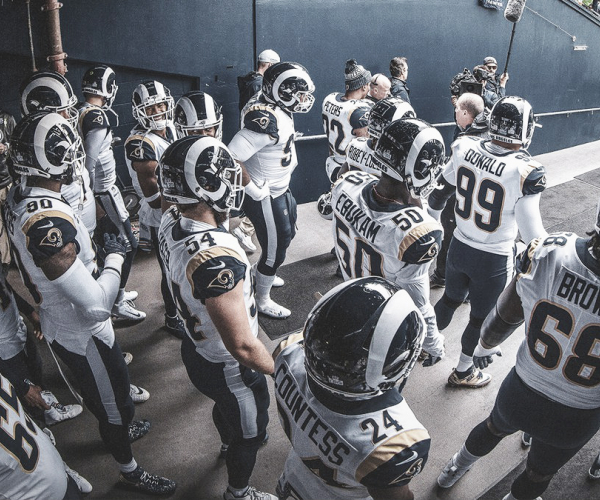
Los Angeles Rams

1936 Los Angeles, CA
The history of the Los Angeles Rams is a chronicle of triumph, change and resilience that spans from their founding in 1936 to the present day. Originally based in Cleveland, the Rams moved to Los Angeles in 1946, becoming the first NFL team to operate on the West Coast. Over the years, the Rams have enjoyed periods of success, including NFL championship victories in 1945 and 1951, as well as Super Bowl wins in 1999 (as St. Louis Rams) and 2021.
Innovation on and off the field
The introduction of helmet insignia by the Rams was not just an aesthetic decision; it represented a pioneering vision that combined sports and visual marketing. This distinctive pair of ram's horns not only reinforced the franchise's identity but also became one of the most recognizable brands in sports, an innovation that helped the Rams stand out in the nascent television era and connect with a wider audience.
Golden Era on the Field
Under the leadership of legendary figures like Bob Waterfield and Norm Van Brocklin, the Rams established themselves as a dominant force in the NFL. Their high-powered offense, complemented by talents such as Elroy Hirsch and Tom Fears, defied the conventions of the era and led the team to the pinnacle of success with the 1951 NFL championship. This period not only marked the Rams' rise as serious contenders but also solidified their reputation as innovators in game strategy.
Legacy of Innovation and Excellence
Since their inception, the Rams have been synonymous with innovation, both on and off the field. The early adoption of visual marketing strategies and the development of a potent offensive attack not only established a unique identity for the Rams but also laid the foundation for the future of professional American soccer. Over the years, the franchise has continued to build on this legacy, adapting and evolving to remain competitive in the changing NFL landscape.
The Los Angeles Rams' era of innovation and change under the ownership of Dan Reeves and, later, Carroll Rosenbloom, was a period of remarkable success and transformation for the franchise. Following the landmark transaction in 1972 that led to Rosenbloom taking control of the team, the Rams experienced a golden period, dominating the NFC West with seven consecutive titles between 1973 and 1979.
NFC West dominance
This dominance in the division was no fluke. It was the result of a combination of exceptional talent, innovative strategy and a success-oriented team culture. Rosenbloom's management and the coaching direction of figures like Chuck Knox took the team to new levels of competitiveness, establishing the Rams as a dominant force in the National Conference.
The Birth of "The Fearsome Foursome."
One of the most iconic aspects of this era was the formation of "The Fearsome Foursome," one of the most feared and dominant defensive lines in NFL history. This quartet, which included Deacon Jones, Merlin Olsen, Rosey Grier and Lamar Lundy, revolutionized defense in soccer, demonstrating the value of constant pressure on the opposing quarterback and setting records in sacks and tackles for loss that still resonate throughout the league.
Challenges to the NFL Championship
Despite their regular season success and dominance in the NFC West, the Rams faced difficulties translating that success into NFL championship victories. Although they reached several NFC championship games during this period, the team struggled to overcome the final hurdle to the Super Bowl. This quest for an NFL championship would continue to challenge the franchise until their eventual move to St. Louis, where they would finally capture the coveted title in Super Bowl XXXIV.
This period of innovation and change not only cemented the Rams as a powerhouse in the NFL but also laid the groundwork for future success, demonstrating the importance of a solid team strategy and the ability to adapt and evolve within the league. The era of Rosenbloom and "The Fearsome Foursome" remains a vital part of the Rams' legacy, reminding fans and the league of the lasting impact the franchise has had on professional soccer.
Transition to St. Louis and Super Bowl Success
The Rams' move to St. Louis in 1995 opened a new chapter for the franchise, which reached one of its highest points with victory in Super Bowl XXXIV in 1999. This triumph was led by then-unknown Kurt Warner, who emerged from the AFL and NFL Europe to become one of the NFL's most accomplished quarterbacks, and a dynamic aerial attack that earned the nickname "The Greatest Show on Turf." This team, which also included talents such as Marshall Faulk, Isaac Bruce and Torry Holt, revolutionized offensive play in the NFL and left a lasting legacy of creativity and innovation on the field.
Return to Los Angeles and Rebirth
After years of ups and downs in St. Louis, the Rams returned to Los Angeles in 2016, ushering in a new era for the franchise in a city that had been their home for nearly five decades prior to their move to St. Louis. Under the leadership of young head coach Sean McVay, the Rams experienced a renaissance, characterized by innovative offensive play and a solid defense. This renaissance culminated in a Super Bowl LVI victory, demonstrating the franchise's resilience and ability to reinvent itself.
Future and Legacy
The Rams are known for their lasting impact on American soccer, including their influence on strategic innovation and sports marketing. As they continue their journey in Los Angeles, the Rams look to build on their rich heritage and forge new chapters of success in the NFL. The franchise strives to maintain its legacy of excellence and continue to be a positive influence both on and off the field.
The Rams' story is one of adaptation, success and perseverance. From their early days in Cleveland to their successes in Los Angeles and St. Louis, and again in Los Angeles, the Rams have proven to be a franchise capable of overcoming challenges and reaching new heights of success. As they look to the future, the Rams are poised to continue their story, adding new chapters filled with accomplishments and memorable moments for their fans and for the history of professional soccer.








































